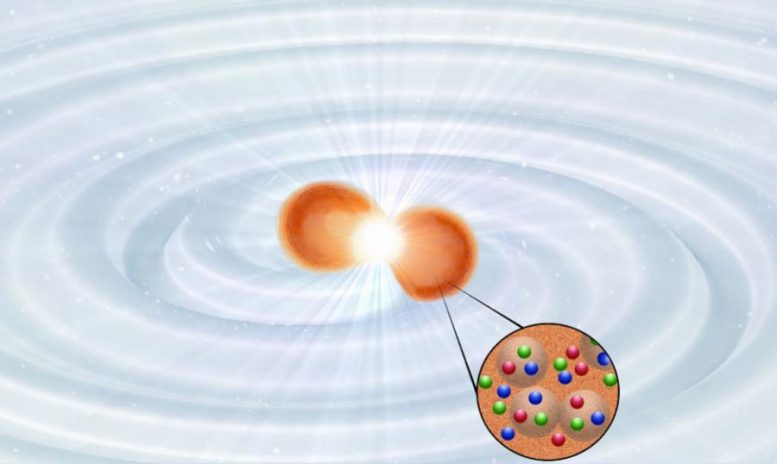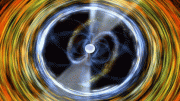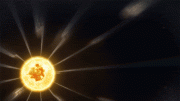
Collision of two neutron stars showing the electromagnetic and gravitational-wave emissions during the merger process. The combined interpretation of multiple messengers allows astrophysicists to understand the internal composition of neutron stars and to reveal the properties of matter under the most extreme conditions in the universe. Credit: Tim Dietrich
Study finds neutron stars are typically about 11.75 kilometers in radius, and provides a novel calculation of the Hubble constant.
A combination of astrophysical measurements has allowed researchers to put new constraints on the radius of a typical neutron star and provide a novel calculation of the Hubble constant that indicates the rate at which the universe is expanding.
“We studied signals that came from various sources, for example recently observed mergers of neutron stars,” said Ingo Tews, a theorist in Nuclear and Particle Physics, Astrophysics and Cosmology group at Los Alamos National Laboratory, who worked with an international collaboration of researchers on the analysis to appear in the journal Science on December 18, 2020. “We jointly analyzed gravitational-wave signals and electromagnetic emissions from the mergers, and combined them with previous mass measurements of pulsars or recent results from NASA’s Neutron Star Interior Composition Explorer. We find that the radius of a typical neutron star is about 11.75 kilometers (7.3 miles) and the Hubble constant is approximately 66.2 kilometers (41.13 miles) per second per megaparsec.”
Combining signals to gain insight into distant astrophysical phenomena is known in the field as multi-messenger astronomy. In this case, the researchers’ multi-messenger analysis allowed them to restrict the uncertainty of their estimate of neutron star radii to within 800 meters.
Their novel approach to measuring the Hubble constant contributes to a debate that has arisen from other, competing determinations of the universe’s expansion. Measurements based on observations of exploding stars known as supernovae are currently at odds with those that come from looking at the Cosmic Microwave Background (CMB), which is essentially the left over energy from the Big Bang. The uncertainties in the new multimessenger Hubble calculation are too large to definitively resolve the disagreement, but the measurement is slightly more supportive of the CMB approach.
Tews’ primary scientific role in the study was to provide the input from nuclear theory calculations that are the starting point of the analysis. His seven collaborators on the paper comprise an international team of scientists from Germany, the Netherlands, Sweden, France, and the United States.
A combination of astrophysical measurements has allowed researchers to put novel constraints on the radius of a typical neutron star and provide a new calculation of the Hubble constant that indicates the rate at which the universe is expanding.
“We studied signals that came from various sources, for example recently observed mergers of neutron stars,” said Ingo Tews, a theorist in Nuclear and Particle Physics, Astrophysics, and Cosmology group at Los Alamos National Laboratory, who worked with an international collaboration of researchers on the analysis to appear in the journal Science on December 18. “We jointly analyzed gravitational-wave signals and electromagnetic emissions from the mergers, and combined them with previous mass measurements of pulsars or recent results from NASA’s Neutron Star Interior Composition Explorer. We find that the radius of a typical neutron star is about 11.75 kilometers (7.3 miles) and the Hubble constant is approximately 66.2 kilometers (41.13 miles) per second per megaparsec.”
Combining signals to gain insight into distant astrophysical phenomena is known in the field as multi-messenger astronomy. In this case, the researchers’ multi-messenger analysis allowed them to restrict the uncertainty of their estimate of neutron star radii to within 800 meters.
Their novel approach to measuring the Hubble constant contributes to a debate that has arisen from other, competing determinations of the universe’s expansion. Measurements based on observations of exploding stars known as supernovae are currently at odds with those that come from looking at the Cosmic Microwave Background (CMB), which is essentially the left over energy from the Big Bang. The uncertainties in the new multimessenger Hubble calculation are too large to definitively resolve the disagreement, but the measurement is slightly more supportive of the CMB approach.
Tews’ primary scientific role in the study was to provide the input from nuclear theory calculations that are the starting point of the analysis. His seven collaborators on the paper comprise an international team of scientists from Germany, the Netherlands, Sweden, France, and the United States.
Reference: “Multimessenger constraints on the neutron-star equation of state and the Hubble constant” by Tim Dietrich, Michael W. Coughlin, Peter T. H. Pang, Mattia Bulla, Jack Heinzel, Lina Issa, Ingo Tews and Sarah Antier, 18 December 2020, Science.
DOI: 10.1126/science.abb4317









Hmm, the whole article is repeated twice. Doesn’t anybody edit these things?
Oh, wow! This method use more than the first multimessenger binary neutron star merger, which has been done but is statistically problematic. Here the expansion rate derivation is still just the one event, though the equation of state is using several events and its robustness lends more robustness to the light curve observations.
“We performed a joint analysis of the gravitational-wave event GW170817 with its electromagnetic counterparts AT2017gfo and GRB170817A, and the gravitational-wave event GW190425, both originating from neutron-star mergers. We combined these with previous measurements of pulsars using x-ray and radio observations, and nuclear-theory computations using chiral effective field theory, to constrain the neutron-star equation of state. We found that the radius of a 1.4–solar mass neutron star is 11.75 +0.86 -0.81 km at 90% confidence and the Hubble constant is 66.2 +4.4 -4.2 [km s^-1 Mpc^-1] at 1σ uncertainty.”
The integrated, whole universe values routinely come out at 68 km s^-1 Mpc^-1, while some near space (low z) methods can give estimates up to 74 km s^-1 Mpc^-1. Notably such tend to use the so called distance ladder that tries to give distances by step wise methods, starting with parallax measurements of distances to nearby stars. A paper that apply various methods on a vast set of galaxy observations get 70 km s^-1 Mpc^-1 [“Mean Estimate Distances for Galaxies with Multiple Estimates in NED-D”, Ian Steer, The Astronomical Journal, Oct. 7 2020].
Big Bang, are you still going with that?
Sort of, it is a century old observational fact you know (Sliper, Hubble).
But 40 years ago it was observed that a Big Bang defined as the observable universe expanding from a small volume would give a much more inhomogeneous and anisotropic universe than we see. (It was akin to pre-big bang ideas of “explosions” in that sense.) That ushered in inflation observations, which crowning achievement was the cosmic background spectra seeing it [COBE 1993, WMAP 2003] and describing it as a simple Higgs-like scalar field [Planck collaboration 2018].
So the modern cosmology is inflationary hot big bang cosmology, with hot big bang commonly defined as the few minutes long brief era after inflation stops until matter dominates and nucleosynthesis starts. [If that confuses you, you may try this short video scripted by an astrophysicist and devoid of confusing mechanism descriptions: “The Big Bang is Probably Not What You Think It Is” https://www.youtube.com/watch?v=P1Q8tS-9hYo&ab_channel=DoS-DomainofScience .]
I.e. “describing it as a simple Higgs-like scalar field [Planck collaboration 2018]” is describing the expansion process as a state that slowly rolls down a simple Higgs-like scalar field.
In principle that is eternal inflation since inflationary volumes of space – well – inflates faster than volumes drop out of the process to become hot big bang universes. But this is a (most likely) hypothesis, not an observation, just an explanation for how it fits with the video pointing out that we don’t know how long the inflation era was before our hot big bang happened.